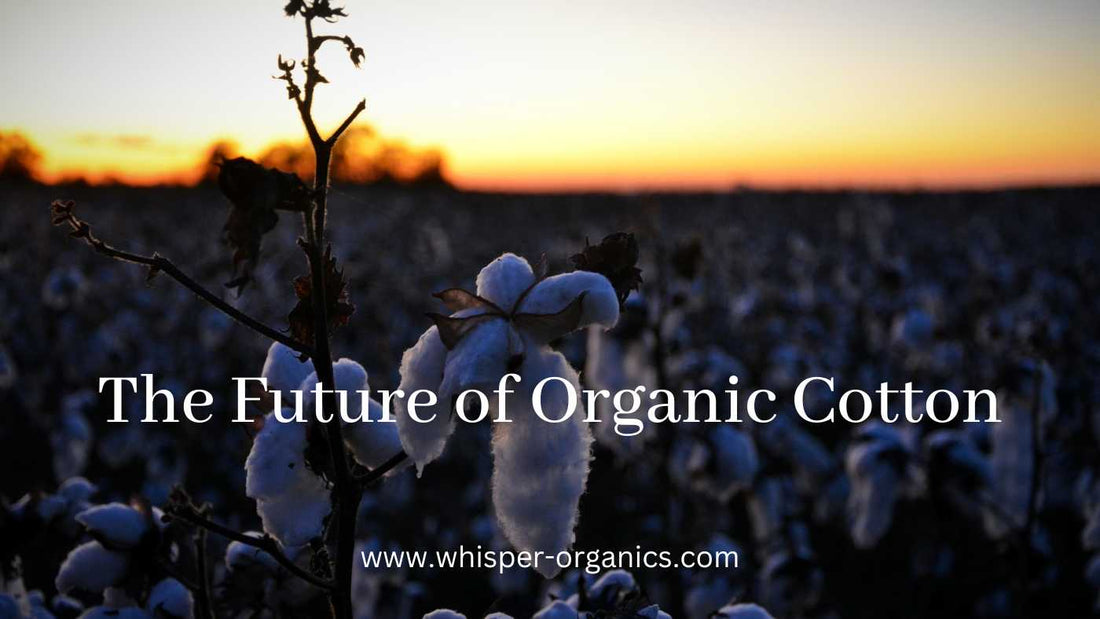In 2013, Vivek and Juli Cariappa, organic farmers based in Mysore, India could not promote organic cotton easily. Back then, organic cotton had little value in a market dominated by transnational companies and global brands.
Ten years later, organic cotton remains significantly small. Its percentage in the global cotton market is still at 0.95 percent due to the continued dominance of regular cotton.

While demand for organic cotton keeps growing, it still could not attract a huge following among global consumers.
Is there really a promising future for organic cotton as the main source of cotton fabric?
The Global State of Organic Cotton
Organic cotton is the ideal means to make cotton production sustainable. Cotton is grown and processed without the use of synthetic pesticides and fertilizers. Unlike traditional cotton farmers, organic cotton farmers use natural methods. Their means to control pests and fertilize the soil are environment-friendly.

Unfortunately, the current demand growth for organic cotton is not enough to supplant regular cotton in the global market.
Data from the Organic Cotton Market Report 2022 shows the production of organic cotton jumped from 249,153 tons in 2019/20 to 342,265 in 2020/2021. But the report also says these numbers account for only 1.4 percent of all global cotton produced from 2020 to 2021. 
Despite the small percentage of organic cotton in the global market, there are promising factors to look forward to.
Promising Factors for Organic Cotton
Increasing demand for organic cotton
One promising factor is the increasing demand for organic cotton products. Global demand increased by 40 percent in 2021 (USD637.1 million), according to Fortune Business Insights Market Research Report. If this trend continues, the organic cotton market can grow up to USD6,730.9 million in 2028.
This growth has a lot to do with consumer education. More buyers are now aware their purchases affect the environment. Many are choosing organic cotton products over conventional cotton.
According to a 2018 study from Accenture on purpose-driven consumerism, around 48 percent of consumers discard brands not aligned with their social views. Around 42 percent walk away from products offered by companies that negatively respond to social issues.
The demand for organic cotton can grow further. When consumers buy organic cotton bedding, they pressure farm owners and manufacturers to invest more in organic cotton farming.
Rise of Sustainable Fashion
Another promising factor in the organic cotton industry is the rise of sustainable fashion as a social movement. Sustainable fashion advances the need for corporate transparency - a central element in the sustainable investment agenda or ESG (environmental, social, governance).

More and more organizations support the idea of sustainable fashion. In particular, the Global Fashion Agenda (GFA) advances eight priorities brands and manufacturers should carry out:
1. Supply Chain Traceability - Brands and manufacturers need to identify the environmental, social, ethical, and financial impact of their production, from their supply chains to the end consumers.
2. Combating Climate Change - Brands and manufacturers need to embrace methods and measures that can help reduce greenhouse gas emissions, advance renewable energy, and protect biodiversity.
3. Efficient Use of Water, Energy, and Chemicals - Brands and manufacturers should enable sustainable usage of water, energy, and chemicals in their processing stages.
4. Respectful and Secure Work Environments - Brands and manufacturers should promote the universal human rights of all people working along the value chain.
5. Sustainable Material Mix - Brands and manufacturers should develop new and more sustainable fibers in order to reduce the negative effects of existing fibers.
6. Circular Fashion System - Brands and manufacturers should design, produce, sell, and collect products that are reusable and recyclable.
7. Promotion of Better Wage Systems - Brands and manufacturers should collaborate with other stakeholders in the industry to improve existing wage systems.
8. Fourth Industrial Revolution - Brands and manufacturers need to embrace the opportunities in the digitalization of the value chain, and work with governments in helping workers transition to new forms of jobs.
Since the fashion industry has a massive influence on the production of fibers and textiles, the GFA sees the need to invest more in long-term social and environmental sustainability than in short-term financial incentives.
Interestingly, most of the biggest brands still continue traditional practices of sourcing raw materials, denying their yearly outsized carbon footprint.
Based on a 2022 report published by First Insight and the Wharton Baker Retailing Center, nearly 94 percent of fashion retailers believe customers value brand names more than sustainability.
But nearly three-fourths of customers say otherwise, signaling a disconnect between retailers and the consumer market. 
Retailers need to heed the voice of their consumers. First Insight CEO Greg Petro comments:
“This report clearly demonstrates that retailers are leaving money on the table. Brands and retailers must listen to the voice of the customer on issues as critical as sustainability. Consumers want more than performative measures from retailers and brands when it comes to ESG priorities, which will only become more important as Gen Z grows in influence.”
As more consumers become aware of the environmental impact of their fashion choices, sustainable fashion will continue to gain ground in the future.
This movement directly strengthens the use of organic cotton in bedding products. Consumers of mattress covers and protectors, blankets, comforters, and pillowcases need sustainable and environment-friendly alternative to regular cotton.
Whisper-Organics, for example, is a strong proponent of sustainability. Our aim is to minimize and eliminate the negative impact of the our products on the environment and promote social responsibility.
We believe in protecting our environment through healthy and sound farming and production practices that treat people and the environment with proper care and dignity. 
Increasing focus on ethical business practices
Another promising factor is the focus on ethical business. Consumers today are becoming more concerned about the working conditions of the people who produce the items they buy, demanding companies adhere to ethical production standards.
This helps increase demand for organic products. Consumers know that products with organic labels as more ethical, since they use materials free from harmful chemicals and from pesticides. They are hesitant to buy brands known to promote unfair labor practices.
A 2020 study from the Vogue Business Index among luxury consumers revealed that environmental and labor policies are key purchase drivers across all age groups. Specifically, there is a growing preference for a brand’s commitment to ESG issues as an important factor when making luxury purchases. 
This trend will continue in the future as consumers become more concerned about the social impact of their purchases.
Improved technology for organic farming
Another promising feature is the improvement of technology used in the organic cotton industry.
Advancements in robotics, artificial intelligence, and machine learning are potential game changers in agriculture, helping farmers improve the quality of their crops, increase their yields, and decrease their operating costs.
Many organic cotton farmers and manufacturers are integrating robotics and AI-controlled machines for efficient harvesting yields and pest management. 
The challenge with these machines is their cost. A robotic harvesting machine can cost nearly $1 million, making it cost-prohibitive for farms under 3 square miles to purchase. The good news is smaller robotic units that can sell below $20,000 are currently under production, according to Dr. Ed Barnes, Cotton Inforporated’s Senior Director of Agriculture & Environmental Research.
Once these units are made available in the market, production of organic cotton will increase and compete better with regular cotton, resulting in more sustainable products in the market for consumers.
Government regulations promoting environmental sustainability
The future of organic cotton is also promising because of government regulations and policies designed to promote sustainability. In the US, several executive orders have been passed to reduce emissions at all federal operations, promote clean energy industries, and create clean, healthy, and resilient communities. Aimed at catalyzing America’s Clean Energy Economy, these EOs have five ambitious goals:
1. By 2030, achieve 100 percent carbon pollution-free electricity, with 50 percent locally supplied to meet 24/7 demand of communities;
2. By 2035, achieve 100 percent zero-emission vehicle (ZEV) acquisitions; plus 100 percent zero-emission light-duty vehicles by year 2027;
3. On or before 2050, achieve net-zero emissions from federal procurement, along with a Buy Clean policy to advance the use of construction materials with less embodied emissions;
4. By 2045, achieve net-zero emissions building portfolio, including a 50 percent reduction of emissions by year 2032;
5. By 2050, achieve net-zero emissions from overall federal operations, as well as a 65 percent reduction in emissions by 2030.
Governments around the world are also taking steps to reduce the environmental impact of textile production, and organic cotton is seen as essential for this effort to succeed. Policies include regulations on the use of synthetic pesticides and fertilizers in farms, along with incentives for farmers who grow organic cotton to encourage more environment-friendly and sustainable production methods.
Remaining challenges
Although organic cotton can potentially replace the use of regular cotton in the market, it still faces several challenges.

The main challenge with organic cotton is still its production cost. It takes more time and resources to grow organic cotton. Yields of organic cotton farms are lower than regular cotton, making it more expensive to produce at scale.
Another challenge is the commitment of global brands to support organic cotton. It is difficult for a profit-driven economy to change existing production models for the sake of sustainability when its short- to medium-term results can lead to profit losses.
Moreover, because of economic recessions around the world caused by the problems such as the 2020 global pandemic and climate change, the majority of consumers may be unwilling to pay a premium for organic cotton clothing.
Another factor to consider is the impact that organic cotton has on the environment. Although organic cotton production is a more sustainable alternative to regular cotton, it does require large amounts of land. It also has its share of carbon emissions, like when raw materials are transported to manufacturing plants and when organic cotton products are delivered to retailers.
Despite these challenges, organic cotton production and usage is still the right direction towards more sustainable and environmentally friendly economy. In the meantime, buyers can play a role in promoting organic cotton by supporting brands that use organic cotton in their products.
Conclusion
The future of organic cotton is bright. Demand for organic cotton products in the market will continue to grow as consumers become more concerned about the environmental and social impact of their purchases.
Production of organic cotton will increase and expand as technology becomes more affordable and as brands and manufacturers become more committed to ethical production practices.
In time, organic cotton will have widespread use and eventually replace regular cotton as the main fiber in cotton products.

